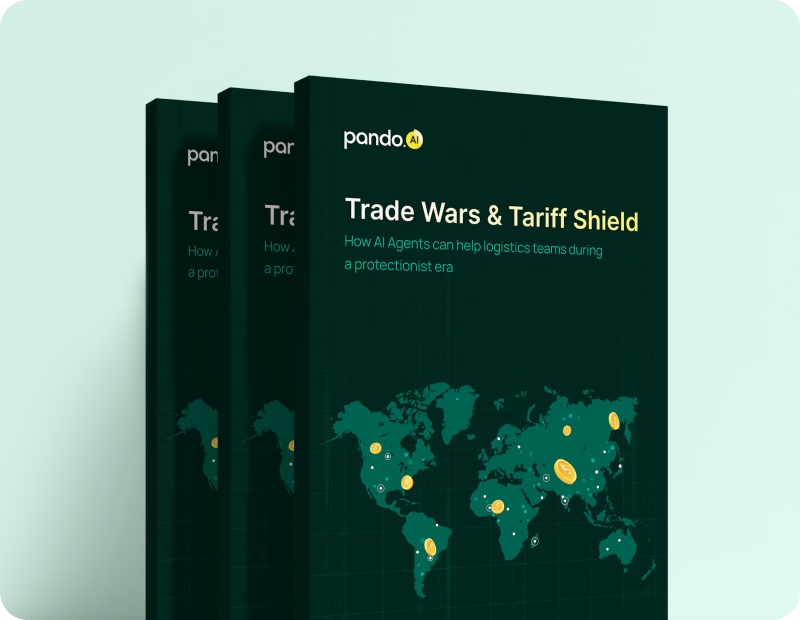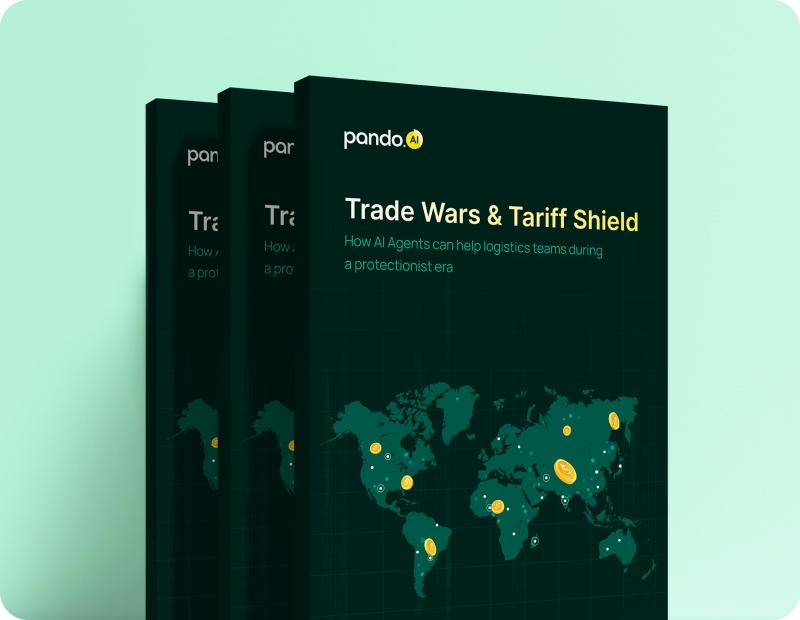-
Products Products
- Industry
- Initiatives
- Resources
- Company
- Book a demo

Before you go: Logistics leaders just dropped the truth on AI
The State of AI in Logistics 2025 is here — no hype, just real conversations and raw insights.
Building a business case to invest in Transportation Management System – Part 1
Discover how KPI driven business case for your TMS investment can help you secure stakeholder alignment and build a resilient supply chain.
Published on January 19, 2024 • 7 mins read
Ganesh Iyer

Discover how KPI driven business case for your TMS investment can help you secure stakeholder alignment and build a resilient supply chain.
As the supply chain and logistics leader of a large enterprise, you find yourself at the helm of a critical decision-making process – selecting and implementing a Transportation Management System (TMS) to optimize & automate your transportation operations. This task goes beyond merely choosing a vendor; it involves engaging, influencing, and convincing key stakeholders across various departments like IT, finance, and procurement to secure the necessary investment and resources for this digital transformative initiative. In this challenging context, building a strong business case aligned with your organization's goals emerges as the linchpin of your strategy to drive collaborative decision-making.
Why should you invest time in building a business case?
In this age of freight volatility and supply chain disruptions, efficient transportation operations are pivotal for maintaining competitiveness. The introduction of a new transportation management system or the upgrade of your legacy solution can make logistics and supply chain a core competency within your organization. To secure support and allocate resources effectively for this transformative initiative, constructing a business case becomes imperative. Here's why:
-
Alignment with business goals - Craft a compelling business case to align your TMS solution with your business goals and objectives. Ensure your investment harmonizes seamlessly with your organization's strategic direction. Check out this video where Neha Parekh, Director of supply chain, Nivea, explains her digitalization framework that includes change management and goal setting.
-
Cross-functional consensus - As you introduce a Transportation Management System (TMS) or any new digital solution, address cross-functional dependencies across IT on the integration landscape, finance on company budgets, and procurement on vendor finalization. Foster collaboration & secure consensus through a shared vision for a frictionless TMS implementation.
-
Secure funding and maximizing RoI - To build a solid business case, you need to lay out a clear justification for your investment. Emphasize the expected benefits, costs, and return on investment (ROI) to persuade decision-makers to greenlight the budget and garner support from stakeholders throughout the organization. Take the time to assess various solution vendors, and put a numerical value on anticipated benefits such as cost savings, efficiency improvements, and enhanced customer service. Compare these figures against the associated costs like software expenses, training, and maintenance. This meticulous evaluation within the business case is crucial for optimizing the selection and configuration of your TMS, aiming for the maximum possible ROI.
-
Guiding implementation and measuring success - Your business case should outline the goals and objectives of implementing a TMS. This roadmap will keep your project on track, ensuring that resources are allocated effectively, and progress is measured against defined metrics. It will become the baseline for evaluating the success of your TMS implementation. Watch this video featuring Mayank Panday, Supply Chain Director, Castrol, discussing the key factors he believes are crucial for successfully implementing a TMS.
-
Identifying and mitigating risks - You must conduct a comprehensive analysis of potential challenges and risks associated (technical, operational) with the TMS implementation in the business case. This enables you to develop proactive mitigation strategies, minimizing disruptions and ensuring a smooth rollout.
-
Managing the TCO (Total cost of ownership) - Incorporating a holistic approach requires you to supervise costs throughout the software's lifecycle. This includes not just the implementation phase but also ongoing operational, maintenance, and potential hidden expenses. When you effectively manage Total Cost of Ownership (TCO), you are not just optimizing your initial investment. You are also establishing the foundation for sustained success, enabling your talent and scaling business growth within a digital enterprise.
Establishing key business metrics and functional KPIs
When building a business case for a TMS, take a meticulous approach by examining key business metrics and supply chain and logistics functional KPIs. These metrics form the quantitative foundation for assessing the impact of implementing a TMS. Here are some essential factors to consider:
Cost focused metrics:
Cost-focused metrics in logistics and supply chain management are crucial for ensuring operational efficiency, sustainability, and overall success. While businesses on legacy platforms may find comfort in familiarity, embracing these metrics offers enhanced control, optimization, and adaptability. Pick up the cost-based metrics that are relevant to your business. Here are some metrics:

Operational efficiency metrics:
Operational efficiency is paramount in supply chain and logistics, directly impacting the company's reputation & financial success. Focusing on key metrics allows businesses to pinpoint improvements, streamline processes, and boost overall performance. Neglecting these metrics risks missing opportunities to cut costs, increase profitability, and remain competitive in a dynamic market.

Freight audit accuracy metrics:
Freight Spend Management is becoming critical in this age of freight rate volatility & disruptions in supply chains. With Freight spends contributing 8-20% of revenue across industries, every manufacturer & retailer has 100% visibility of their freight spends globally. More than 80% of manufacturers and retailers overpay on their freight bills as the freight audit process is manual or most tools lack the finesse to perform a 4-way match between invoices, contracted rates, PoD, and PO. The result? A cacophony of anomalies, duplicate charges, and audit inaccuracies. Consider this list of metrics to measure freight audit accuracy:

Unveiling the hidden costs of NOT using a TMS
Your supply chain isn't a weekend carpentry project. It's a finely tuned engine driving the heart of your business. And just like you wouldn't build a house without a detailed plan, attempting to navigate your supply chain without a strong TMS is a recipe for frustration and financial loss. A solid TMS is your blueprint for supply chain success. It provides the clear vision and structure you need to ensure your goods reach their destination:
Let’s explore the hidden costs of not having a robust Transportation Management System. Discover missed opportunities, inefficiencies, and potential overpayments that could be affecting your business resources.
- Transport execution cost: Picture your team wrestling with multiple screens, struggling to piece together the puzzle of your shipments. Feeling exhausted from data silos that create communication black holes and lead to delayed response times? Spending valuable time on visibility with inefficient tools rather than taking meaningful action? Ever encountered missed delays and issues due to the absence of granular, SKU-level tracking? Check this video where Praveen Sharma, Head of Logistics and Distribution, Godrej, discusses the challenges of silos, emphasizing the issues with isolated approaches.
- Freight procurement cost: Don't be deceived by your assumption of securing optimal rates; market volatility can rapidly sway prices. Operating without a TMS leaves you in the dark, missing out on essential insights. However, with the right tools, you gain access to new vendors with competitive rates and stellar performance, lightning-fast spot procurement that reacts to market fluctuations, and data-driven insights to avoid repeating past mistakes in choosing vendors, routes, and lanes.
- Dispatch decision cost: Is your dispatch plan characterized more by improvisation than strategic foresight? If you find yourself nodding, then you might be susceptible to manual, time-consuming planning that leaves little room for scenario comparisons and optimization, and misleading ETAs that frustrate customers and disrupt your entire operation. Ignoring crucial factors like density, volumetric weights, and optimal mode/carrier selection might hinder your efficiency. Missed "clubbing" opportunities that may leave trucks underutilized. However, recognizing these challenges is the first step toward transforming your dispatch strategy into a well-orchestrated and efficient operation.
- Freight overpayment cost: Are you drowning in a sea of invoices and unclear budgets? Here's how a leaky TMS (or no TMS at all) can cost you a lot: Limited invoice auditing leaves the door open for hidden charges and overpayments. Constant disputes with carriers about payment status and discrepancies. Confused finance teams grappling with invoice issues and recovery struggles. However, there's a silver lining. By addressing these issues head-on and implementing an effective TMS, you can navigate through the storm and achieve smoother financial operations.
The hidden costs are not mere ghosts; they are tangible problems with clear solutions. A robust TMS serves as your flashlight, map, and compass, guiding you through the challenges of your supply chain. So, stop driving blindfolded. Embrace visibility, optimize your processes, and watch your profits go up. To further explore and quantify potential savings based on your specific situation, you can utilize this RoI calculator.
Navigating the path to digital transformation
In Part 1 of our series, we explored how this blog serves as a comprehensive guide to the intricate process of constructing a business case for the implementation of a Transportation Management System (TMS). Beyond vendor selection, it highlights your crucial role as a logistics leader in strategically positioning the TMS initiative through a persuasive narrative. This isn't merely about a technological upgrade; it represents a transformative leap in the dynamic landscape of supply chain and logistics. By crafting a compelling story around TMS, this approach ensures not only financial support but also aligns stakeholders, fostering a unified vision for operational excellence.
But this is only the beginning. In Part 2, we'll delve even deeper into the complexities of engaging, influencing, and convincing key stakeholders across different departments to secure the required investment and resources for a successful TMS implementation. Explore the potential risks, challenges, and objections that may surface during this process. As we navigate through these intricate aspects, you'll gain valuable insights into overcoming obstacles and ensuring a powerful foundation for your TMS initiative. Stay tuned for a deeper understanding of the hurdles and strategies essential for steering your organization toward operational excellence in the realm of supply chain and logistics.
Subscribe to Pando blog and Crossroads newsletter now!
Stay up to date with the latest logistics, transportation, and supply chain tips and news.
Subscribe Here!

Related blogs
Building a business case to invest in Transportation Management System – Part 2

Is your TMS equipped for international shipping? Here's what you're missing.











